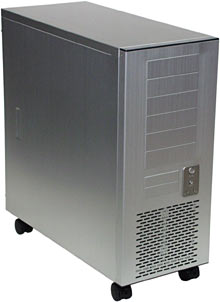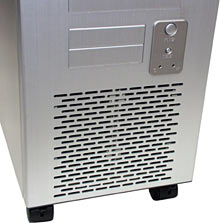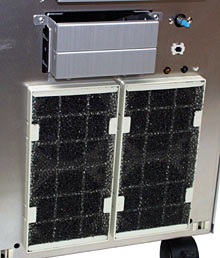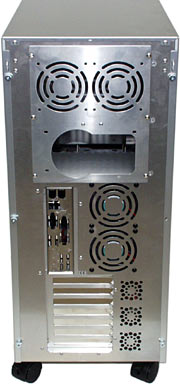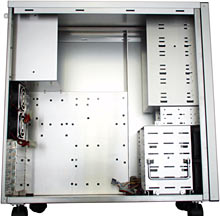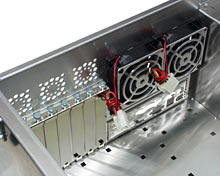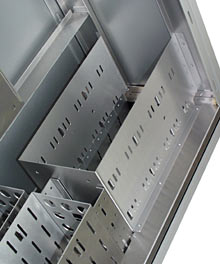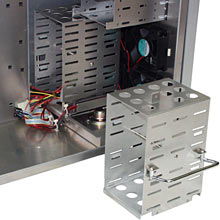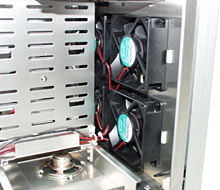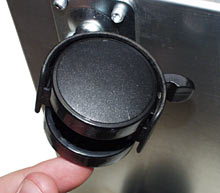
Lian Li PC-76 server case
Review date: 3 October 2001.Last modified 03-Dec-2011.
Do you believe big to be beautiful?
Well, in that case, you'd probably think Lian Li's PC-76 case was beautiful, no matter what it was made of. It is, undeniably, a large sucker.
The PC-76 isn't actually the biggest case Lian Li currently make (because there's a PC-78, as well...), but it's almost there. It's bigger than their full-tower PC-70 (which I review here). And it's much bigger than their already quite capacious midi-tower cases, like the good old PC-60 which I review here.
You're not meant to put any kind of normal PC in a case this big, though you can if you want to. Doing that is like using a dump truck to drive to the supermarket, though; this is a server case, with a ton of 3.5 inch drive bays and lots of ventilation.
But this is, of course, a Lian Li server case, m'sieu. Not some humble beige-steel offering. So it's made of aluminium with a clean brushed-metal finish, and its overall styling is the same as that of the PC-60 and PC-70. Bauhaus. Very expensive-European-kitchen-appliancey.
The PC-70 looks like a PC-60 on steroids. The PC-76, in turn, looks like a PC-60 that was bitten by a radioactive hippopotamus.
This case is about 575mm high - not counting the casters on the bottom - by 265mm wide by 590mm deep. That's 22.6 by 10.4 by 23.2 inches. So it's about the same height and depth as the PC-70, but it's noticeably wider.
And now, the guided tour.
The PC-70 and PC-60 each have two 80mm front intake fan locations. Each of those spots has a fan installed as standard. The PC-76 has four pre-installed front fans, behind a somewhat freer-breathing slotted grille than the smaller Lian Lis offer.
The surround around the PC-76's front panel buttons is the same grey gloss-finish plastic as on the PC-60 and PC-70, and the front panel also has the same strips of fake woven carbon fibre on its top and bottom. Unlike some fake carbon fibre, this painted shiny plastic actually looks like real carbon fibre.
The PC-76's front panel is held on with the same nice solid no-rattle clips as Lian Li use on all of their cases these days, which makes it easy to pop it off and get access to the foam filters over the fans.
One thing that's missing on the PC-76 is a speed control switch for the front fans. The smaller Lian Li cases have a three-position switch that lets you run the fans at about two-thirds power, or at about two-fifths power, if you don't need their full cooling capacity. Lower speed means considerably less noise, longer fan bearing life, and slower encrustation of the filters with dust. But the PC-76 is expected to be packed with drives and need full fan power all the time, so its front fans are just wired straight to normal pass-through power supply cable connectors.
The back of the PC-70 has standard ATX-motherboard panel holes, and a pair of grilles for the two pre-installed 80mm exhaust fans. There are three grilles the right size for 40mm fans next to the card slot area, but there's very little point installing fans there. The four front fans ought to be able to introduce about six times as much air into the case as three 40mm fans could exhaust, all things being equal, so there'll probably be no perceptible difference if you just leave these fan mounts as passive exhaust holes.
As with other Lian Li cases, this one is held together with thumbscrews that don't require a screwdriver, as long as nobody's over-tightened them.
Back at the front of the case, the drive bay covers are retained with a neat click-in nubbin system, with no screws needed. As with other Lian Li design features, this is the sort of thing that'd result in rattles and jams if the case wasn't built to quite fine tolerances. But it is, so it doesn't. As usual for Lian Li cases, everything fits snugly, but not too snugly. So nothing buzzes, and nothing sticks either.
Inside the PC-76, it's a normal enough layout overall. Power supply mounting box at the top rear, drive bays at the front, motherboard mounting area at the bottom rear. This case doesn't have a slide-out motherboard tray, but there's enough room to easily work on the motherboard without one. The motherboard area should have enough acreage to accommodate any PC motherboard on the market today, including extra-large dual processor server boards.
At the back of the motherboard area are the two standard exhaust fans, wired up to more passthrough four pin power connectors, as with the front fans. The shiny die-cut interior fan grilles are standard equipment on all recent Lian Li cases, by the way; they should make it impossible for cables to wander into the fan blades while the machine's on.
There are six 5.25 inch drive bays, each of which is "external" - they have front panel holes, so you can use them for removable media, like CD-ROM drives. Under those are two external 3.5 inch bays, where the PC-70 and PC-60 have three. And under those are the twelve internal 3.5 inch bays.
The PC-76's width allows it to contain a pair of 3.5 inch hard drive cages, each of which can hold six drives. Removing these cages, for mounting of drives, is simple enough; just undo two screws (more thumbscrews, of course), fold out the neat-o carry handle, and yank out the cage. Easy. You have to remove both side panels if you want access to both 3.5 inch cages, though.
"12 3.5 inch bays" means 12 half height 3.5 inch bays, of course. All consumer hard drives these days are half height, but full height 3.5 inch devices are still far from unknown in the serious-SCSI-storage world.
If you're installing full height drives, you can install four - one taking up the top two bays and one taking up the bottom two bays of each of the cages. There's a reinforcing rod through the middle of the cages that stops you from installing a full height device there, and it's probably as well that you don't, for cooling reasons. If you want to, though, you can; the rod is only held in place with a couple of screws, and can easily be removed.
With a 3.5 inch cage removed, you can see the intake fans. All of the fans in this case are standard 80mm ball bearing medium power units made by Sunon; even at full power, they should last well, and with one 80mm fan for every three of the bottom 3.5 inch bays, you shouldn't have a problem installing eight super-hot 10,000RPM+ half height drives in this case, filling bays 1, 3, 4 and 6 in each cage.
Since the 3.5 inch bays are pretty much cheek-by-jowl, I wouldn't be confident about populating all of them with high-RPM half height drives, for the same reason that I don't think it'd be a great idea to install six full height drives. You'd be fine with 12 7200RPM commodity half height drives, though.
The drive cages, like almost everything in the PC-76, are made of aluminium. This will help drive cooling somewhat, because aluminium is a better thermal conductor than steel. Making the outer case panels out of aluminium doesn't make a whole lot of difference, but screwing hot drives firmly to an aluminium cage will let them get rid of more heat by conduction than they would in a conventional case.
If you want to build a 12-device farm out of cheap IDE drives, you'll need to invest in at least one extra cheap IDE controller, even if your motherboard has four IDE connectors. The elegant way to do this is by leaving the motherboard IDE connectors alone, and buying one of the more expensive proper IDE RAID controllers that support more than four drives.
IDE drives don't work as fast in arrays as SCSI ones, and commodity drives aren't as reliable as expensive SCSI units, and high end IDE RAID controllers aren't much cheaper than similar SCSI controllers. But the drive price difference is considerable.
$AU5,400 or so will currently buy you 670 gigabytes (genuine gigabytes, not cheating "1,000,000,000 bytes" hard drive manufacturer gigabytes...) of IDE storage. Buy the same amount of storage in large-capacity SCSI drives from an Australian corporate IT dealer, and it's likely to cost more than $AU20,000. US prices tend to be much more reasonable, but you're still looking at an easy $AU12,000 for SCSI, versus around $AU3900 for the IDE alternative.
When you're saving that much money, you can forgive a lot of sins.
The PC-76's power supply mounting area is like the PC-70's. Which is to say, a bit odd.
The metal enclosure around the PSU area means that some power supplies can't be properly installed. If your PSU has a fan on the bottom - when you hold it so that, from behind, its rear fan is to the left, which is how it'll mount in the PC-76 by default - then installing that PSU in the PC-70 or PC-76 will place the bottom fan right next to the bottom of the case's power supply enclosure, severely restricting air flow.
The plate that the PSU screws onto can be installed either way up, but inverting it will turn a bottom vent into a top vent, rather close to the top of the case, Which will create another, less severe, ventilation problem.
You could turn the mounting plate around to reverse the PSU orientation and solve this problem, but there's a little aluminium right-angle support in the middle of the plate that's pop-riveted in place, and will end up on the outside of the box if the plate's reversed. Drilling out the rivets and bolting the support back in place on the other side of the plate seems to me to be the simplest way to accommodate an inconveniently configured PSU. But if you want a plug-and-go solution, avoid bottom-fan PSUs.
Apparently, Lian Li also make custom mounting plates - just frames with a big rectangular hole in the middle, basically - to accommodate special non-ATX server PSUs. You can vaguely see a couple of these plates in the fuzzy picture on Lian Li's not very useful page for the PC-76, here.
Even with the standard plate, though, the large PSU mount area in the PC-7x cases, with its two mounting points for optional 80mm fans, has lots of potential for merry case modders. There's room for a whole second standard ATX PSU, or a quite hefty radiator for a water cooled system, or a compact UPS; you name it.
If it doesn't have wheels, it's not a server case. The PC-76's casters are ordinary enough, with the usual click-down brake levers that stop your server from going into Dalek mode.
Spend Money Fast!
The down side of all Lian Li cases is that they ain't cheap, and the PC-76 is no exception. The few American dealers that list it generally have it for only $US50 to $US100 more than the PC-70, but that doesn't include delivery. If you're picking the case up yourself then that's not a problem, but if you want a server enclosure delivered to your door, get ready for a nasty surprise.
Aus PC Market's delivered-within-Australia-unless-you-live-in-Bunyip-Creek-or-somewhere price for the PC-76 is a heart-fluttering $AU913, without a power supply. The PC-70 lists for $AU462 delivered, in contrast. I presume that since nobody's expecting to sell a whole lot of PC-76s here in Australia, there aren't a lot of them being brought into the country, and they thus carry a bit of a price premium.
Mind you, all server cases are pretty expensive, and this one's got an unusually large number of drive bays for its size. Many server cases use the "bar fridge" form factor and contain a plethora of 5.25 inch bays, which end up having 3.5 inch drives installed in them with adapter rails. Which is a good airflow solution, but not particularly space-efficient. The PC-76 arrangement is more elegant, it's nicer to work on than the average sharp-metal bar fridge case, and it only costs a couple of hundred bucks more than they usually do.
Overall
This is not a case for boy racers.
OK, some LAN party enthusiasts will probably buy one of these things, populate it with some hot overclockers' motherboard or other and a screaming Athlon, and maybe a water cooling rig as well, pay a hot rod airbrush shop to paint Conan on one side and a woman with bodacious ta-tas on the other, encrust the thing with neon and electroluminescent string and blue LEDs and cigarette lighters and cupholders, and then rip the heck out of their car's upholstery driving it to and from parties.
With a normal complement of PC hardware in it and most of its bays empty, a PC-76 won't weigh any more than a normal tower-cased PC, thanks to its aluminium construction. So any somewhat husky person will be able to get it up stairs, which is more than can be said for the average stacked bar fridge case.
But this is not what the PC-76 is meant for. If you want a Lian Li case for a normal PC, get a PC-60; they're much easier to schlep around, and they've still got more drive bays than most people need.
The PC-76 is a proper x86 server case which just happens to look really swish, and be nicer to work on than the average Big Old Box Of Drive Bays. And compared with the value of the components Lian Li expect you to put in it, even the thrillingly high Australian price of this case isn't all that amazing.
If you want a Lian Li case for a big serious PC, you probably want a PC-70, not a PC-76. But if your case requirements can be summed up as "the whole enchilada, thanks", then you will probably find that the PC-76 is not missing any of the ingredients you demand, and is rather more stylish than you expect.
If you're looking for Lian Li cases in the USA, JCL is a major distributor.
